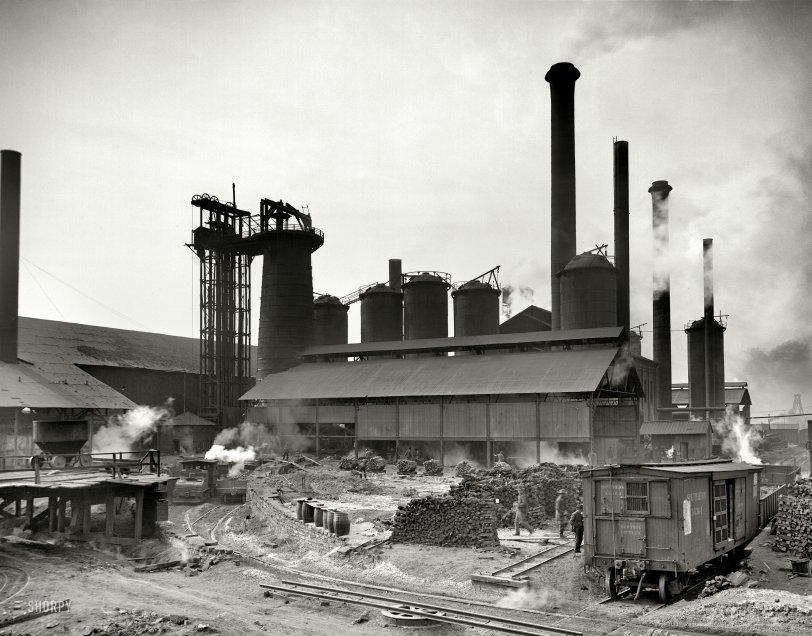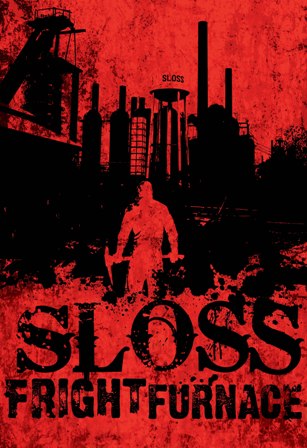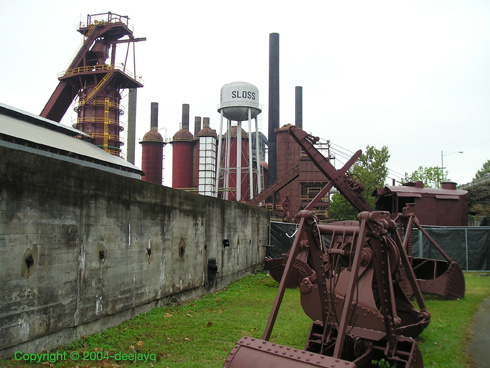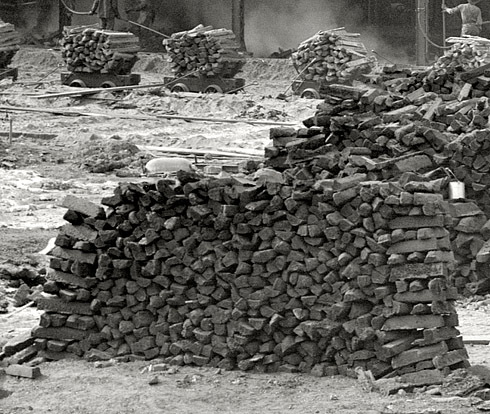


Framed or unframed, desk size to sofa size, printed by us in Arizona and Alabama since 2007. Explore now.
Shorpy is funded by you. Patreon contributors get an ad-free experience.
Learn more.

- Baldwin 62303
- Baldwin VO-1000
- Cold
- No expense spared
- Tough Guys
- Lost in Toyland
- And without gloves
- If I were a blindfolded time traveler
- Smoke Consumer Also Cooks
- Oh that stove!
- Possibly still there?
- What?!?
- $100 Reward
- Freeze Frame
- Texas Flyer wanted
- Just a Year Too Soon
- WWII -- Replacing men with women at the railroad crossing.
- Yes, Icing
- You kids drive me nuts!
- NOT An Easy Job
- I wonder
- Just add window boxes
- Icing Platform?
- Indiana Harbor Belt abides
- Freezing haze
- Corrections (for those who care)
- C&NW at Nelson
- Fallen Flags
- A dangerous job made worse
- Water Stop
Print Emporium
Sloss City Furnaces: 1906

Birmingham, Alabama, circa 1906. "Sloss City furnaces." Four years later, our site's namesake, Shorpy Higginbotham, would be working for the Sloss-Sheffield Iron Co. at nearby Bessie Mine, helping to supply coal for the furnaces at this steel mill. 8x10 inch glass negative, Detroit Publishing Co. View full size.
Sloss Fright Furnace
Around Halloween time, Sloss Furnace is converted into a "haunted house." As you are walked through the place, you are confronted by ghouls, ghosts of angry steel workers, zombies, and psychos. My brother & I went there this past October.

Muse of Fire: Shakespeare at Sloss
I've enjoyed working with Muse of Fire for the past several spring seasons as we perform Shakespeare under that shed in the center of the Shorpy photo. In the fall we stage select Shakespeare scenes in various spots along the walking trail around the Sloss facilities. There's nothing like having trains running by 100 yards from the stage, blowing their whistles for all they're worth.
Having rehearsed late into the night several times, I have to say that it's easy to believe that Sloss is as haunted a place as I've ever been (especially deep in the back near the old brick ovens).
Thanks, Dave, for posting this great photo of a cherished landmark in my hometown. I think of Shorpy Higginbotham at every rehearsal and performance, and I wonder if he's watching us and enjoying the show.

Old Furnaces
Looking at the way things are laid out, and given the time frame visible here, these are the OLD Sloss Furnaces. This view of the furnaces changed in 1927 when the furnaces were totally rebuilt with modern equipment. At the time of this photo, these furnaces had only been in operation 1899. This picture was taken around the time the new boilers were installed.
The Magic City
I, too, grew up in Birmingham in the late '50s and all of the '60s. We heard about "Pittsburgh of the South" in school, of course. It was printed in them Yankee textbooks from up Nawth. But the C-of-C called Birmingham "The Magic City" while I was growing up.
I remember Sloss very, very well, and fondly, too, in a retrospective kind of way. My father worked near Sloss (in a different career field) and we frequently passed Sloss as we travelled over The Viaduct, a raised portion of 1st Avenue North that went right beside Sloss. On some evenings when they would pour out the molten steel huge plumbs of steam would billow forth. These clouds would take on a glow the same bright red-orange color as the molten steel. Traffic would slow briefly along The Viaduct as we would all want to watch the spectacle. There was always an incredible aroma that billowed out along with the steam. It was deep, rich and earthy, somewhere between rotten eggs and burnt coal and wood. When the wind was right, you could smell this aroma even at my parents house in the Roebuck neighborhood, some 8-10 miles from Sloss.
I had to move away from Birmingham in 1969 when My father took a new job. I was so glad to hear they have saved Sloss and turned it into a national monument-- and a performance arts center! I was eager to take the tour when I got back there for my first visit in years back in 2004. Attached is a photo I took then of Sloss today. For anyone wishing to explore Sloss online, may I suggest http://www.slossfurnaces.com/ Thanks, Shorpy, for letting me share some memories with you! -DJQ

Iron Only
Olde Buck basically nailed it. The three ingredients are iron ore, fluxing stone (usually limestone) to draw off impurities, and coke, which adds carbon to the mixture and also burns to superheat the interior.
But, blast furnaces only produce iron. As iron contains many impurities, it’s actually a much weaker metal and more susceptible to stress and fracturing. To make steel, the impurities have to be burned off in a separate facility, or "converter."
In this era, it could be done in a bessemer converter by blowing air into the molten iron. This started a chemical reaction, igniting manganese, then silicon and finally carbon monoxide; took about 20 minutes to burn it all out. Also coming into their own at this time were open hearth furnaces, basically a regenerative furnace, where scrap and molten iron were mixed to create custom blends of steel.
The items in the photo "Stacked" are iron pigs aka "pig iron" – "ingots" are gigantic blocks of partially cooled (just enough so they can be handled) steel that are fed into rolling mills and formed into various shapes such as beams and rail.
Ghost Adventures
I watched an episode of Ghost Adventures where they visited Sloss Furnace. This place really caught my attention and some of the stories that went along with it were pretty crazy.
Mom and Dad and Shorpy
As I child, I lived about three miles from where Shorpy would've lived, Bessie Mines. I live in West Jefferson. Incredible place. My parents met working on Miller Steam Plant.
Worth a visit
This is now one of the most incredible national monuments in our country. The only one I know similar to it is Gas Works Park in Seattle, and you can't actually explore it. You can walk all over Sloss. Just another example of how much incredible potential Birmingham has.
A brief [?] explanation
There are a lot of folks who know more about this than I, but I can give you a simple sketch of what's going on.
The tower just left of the central shed is the charging stack. Note the elevator running up the left side. This is used to haul the ore, limestone and whatever else is needed to the top.
The foreman in charge mixes the ingredients in the correct proportion into the top of the stack. This stuff is heated at high temperature in the blast furnace and when it's all blended and liquefied, the bottom of the stack is opened to allow molten steel to run onto the floor of the large central shed. This molten steel is run down narrow gutters in the floor and turned into molds to cool. These molds full of red hot steel look like little piglets being fed by their mommy. That's where they started calling them "pig iron."
Note the small steam locomotive with its rear facing us to the left below the elevator. Both the engine and the cars down there have link and pin couplers that were outlawed for interstate commerce by about 1900, which indicates this engine and cars may belong to the steel company. It appears they are hauling waste, also called slag, away.
At the far left edge of the photo is a four wheeled railcar with a large pocket on an elevated track. This looks like a "larry car" which was filled with coal and dumped into a coke oven from the top. The oven was sealed shut and the coal was "baked" to create coke, which burns much hotter than coal, which is needed to make steel. I'd say Mr. Shorpy's coal was turned into coke right here in the steel plant. (A single larry car could run atop any number of ovens, which would be off camera here.)
Note in the foreground the narrow gauge plant track on a turntable. This appears to allow the narrow plant track to cross over the wider track at a slight elevation. When the wide tracks are used, the narrow track is turned away as it is here.
Lazy Susan
Love the Southern RR ventilated car, the lazy-susan narrow gauge bridge track, and the link-and-pin couplers on the little engine shoving cars into the plant and the in-house railcars. Very interesting moment in time captured here.
Stacked
I wonder what's going on in the lower center. Looks like a fair amount of wood stacked up, and possibly being burned in the large shed. They might be making charcoal, but why would they bother if coal was available?
[Those are metal ingots. Ore goes in, iron comes out. - Dave]

The Pittsburgh of the South
Growing up in Texas, I was taught that this was one of Birmingham's nicknames. I never really knew if the people of Birmingham ever referred to their city as such.
Fascinating
Steam, smoke, water, stacks of ingots, men bending their backs both with work and also hands in pockets as per the older gent standing at the rail carriage. There's a lot going on here all right. Not a day to hang the washing out!
Can anyone explain the process going on here?
Still there
I took the scenic route back to the airport last summer (in part by "lost by GPS") and it was still there. I did not expect it and was surprised to see the furnace right off the road. Looked it over and U turned to check it out again. Tried to imagine what it was like to see it in production.
Ghost of Sloss
I grew up in Birmingham and went there several times on school tour groups. The guides always pointed out the hidden gravesite of a small dog behind some hedges near one of the side buildings. Apparently the dog was loved by the furnace workers and lived there. I wonder if it's still there!
Heavy Metal
Sloss Furnaces is occasionally used as a concert venue. I saw Rage Against the Machine perform there in the late '90s.
No sign of Shorpy's ghost.
























On Shorpy:
Today’s Top 5